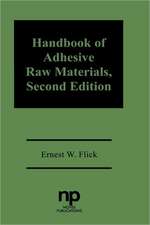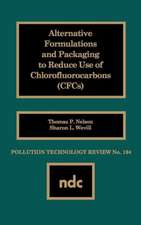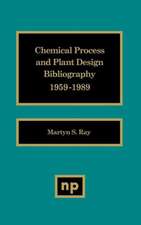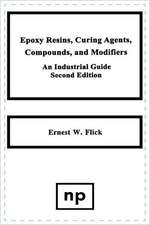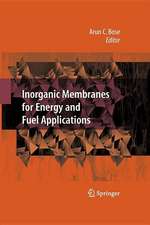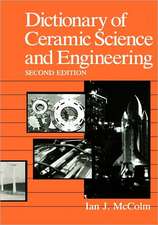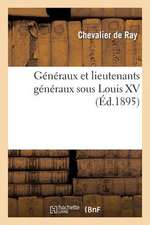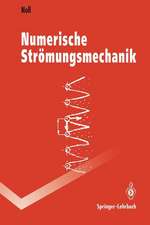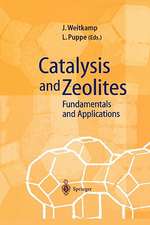Chemical Engineering Design Project: A Case Study Approach, Second Edition
Autor Martyn S Rayen Limba Engleză Paperback – oct 1998
The book embodies the "learning by doing" approach to design. The student is directed to appropriate information sources and is encouraged to make decisions at each stage of the design process rather than simply following a design method. Thoroughly revised, updated, and expanded, the accompanying text includes developments in important areas and many new references.
| Toate formatele și edițiile | Preț | Express |
|---|---|---|
| Paperback (1) | 623.13 lei 6-8 săpt. | |
| CRC Press – oct 1998 | 623.13 lei 6-8 săpt. | |
| Hardback (1) | 1069.71 lei 6-8 săpt. | |
| CRC Press – oct 1998 | 1069.71 lei 6-8 săpt. |
Preț: 623.13 lei
Preț vechi: 733.10 lei
-15% Nou
Puncte Express: 935
Preț estimativ în valută:
119.23€ • 124.49$ • 98.68£
119.23€ • 124.49$ • 98.68£
Carte tipărită la comandă
Livrare economică 04-18 aprilie
Preluare comenzi: 021 569.72.76
Specificații
ISBN-13: 9789056991371
ISBN-10: 905699137X
Pagini: 360
Dimensiuni: 178 x 254 x 19 mm
Greutate: 0.72 kg
Ediția:Revizuită
Editura: CRC Press
Colecția CRC Press
ISBN-10: 905699137X
Pagini: 360
Dimensiuni: 178 x 254 x 19 mm
Greutate: 0.72 kg
Ediția:Revizuită
Editura: CRC Press
Colecția CRC Press
Cuprins
Preface to Second Edition -- Acknowledgements -- Introduction -- I How to Use This Book -- (A) The Case Study Approach -- (B) A “Road Map” -- II Some Advice -- (A) General Advice to the Student -- (B) Advice from a Former Design Project Student -- (C) To the Lecturer -- (D) The Designer or Project Engineer -- III Presentation of Design Projects -- (A) Effective Communications -- (B) General Comments on Preparation of Literature Surveys -- IV Details of Particular Design Projects, and Information Sources -- (A) IChemE Design Projects -- Instructions for the IChemE Design Project, 1980 -- (B) Information Sources -- PART I Technical and Economic Feasibility Study -- Chapter 1 The Design Problem -- 1.1 Initial Considerations and Specification -- 1.1.1 The Feasibility Study -- 1.1.2 Time Management -- 1.1.3 Stages in a Design Problem -- 1.1.4 The Search for Information -- 1.1.5 Scope of the Project -- 1.1.6 Evaluating the Alternatives — Making Decisions -- Some Questions to Ask for the Chemical to be Produced -- Further Reading -- Case Study: Production of Phthalic Anhydride -- Overall Summary for the Technical and Economic Feasibility Study -- 1.2 Case Study — Defining the Problem and Background Information -- Summary -- 1.2.1 Background and Objectives -- 1.2.2 Chemical Structure and Physical Properties -- 1.2.3 Applications and Uses -- 1.2.4 Basic Chemistry -- 1.2.5 Evaluation of Alternative Processing Schemes -- 1.2.6 Conclusions -- 1.2.7 Recommendations -- Chapter 2 Feasibility Study and Market Survey -- 2.1 Initial Feasibility Study -- 2.2 Preliminary Market Survey /Economic Analysis References -- 2.3 Information Sources -- 2.4 Evaluation of Available Literature -- 2.5 Considerations for Literature Surveys References -- 2.6 Case Study — Feasibility Study and Market Assessment -- Summary -- 2.6.1 Market Assessment -- 2.6.1.1 Production: Worldwide -- 2.6.1.2 Production: Regional -- 2.6.1.3 Production: National -- 2.6.2 Current and Future Prices -- 2.6.3 Demand -- 2.6.4 Australian Imports and Exports -- 2.6.5 Plant Capacity -- 2.6.6 Product Value and Operating Costs -- 2.6.6.1 Capital Costs -- 2.6.6.2 Operating Costs -- 2.6.6.3 Approximate Selling Price -- 2.6.7 Conclusions -- 2.6.8 Recommendations -- Chapter 3 Process Selection, Process Description and Equipment List -- 3.1 Process Selection Considerations -- 3.1.1 Flow Diagrams — PFD and P&ID -- 3.1.2 The Reactor -- 3.1.3 Product Purity -- 3.1.4 Process Conditions -- 3.1.5 Process Data -- 3.1.6 Energy Efficiency -- 3.1.7 Factors in Process Evaluation and Selection -- 3.1.8 Choices and Compromises -- 3.1.9 The Optimum Design -- 3.1.10 Process Control and Instrumentation References -- 3.2 Process Description -- 3.3 Preparing the Equipment List -- 3.4 Rules of Thumb -- 3.5 Safety Considerations and Preliminary HAZOP Study References -- 3.6 Case Study — Process Selection and Equipment List -- Summary -- 3.6.1 Trends in Phthalic Anhydride Processing -- 3.6.2 Raw Material -- 3.6.3 Process Configurations -- 3.6.4 Detailed Process Description -- 3.6.5 Advantages of the LAR Process -- 3.6.6 Advantages of the LEVH Process -- 3.6.7 Process Selection -- 3.6.8 Initial Equipment Design -- 3.6.9 Equipment List -- 3.6.10 Conclusions -- 3.6.11 Recommendations -- Appendix A: Preliminary Equipment Specifications -- Chapter 4 Site Considerations: Site Selection and Plant Layout -- 4.1 Site Selection /Location -- 4.1.1 Local Industrial Areas -- 4.1.2 Some Important Factors -- 4.1.3 Prioritizing the Factors References -- 4.2 Plant Layout -- 4.2.1 Plant Layout Strategies -- 4.2.2 Factors Influencing Plant Layout References -- 4.3 Case Study — Site Considerations: Site Selection and Plant Layout -- Summary -- 4.3.1 Background and Objectives -- 4.3.2 Potential Sites -- 4.3.2.1 Kemerton -- 4.3.2.2 Geraldton -- 4.3.2.3 Karratha -- 4.3.2.4 Kwinana -- 4.3.3 Preferred Site and Layout -- 4.3.4 Conclusions -- 4.3.5 Recommendations -- Chapter 5 Environmental Considerations -- 5.1 Environmental Impact Assessment -- 5.2 General Considerations -- 5.3 El A Policy and Scope -- 5.4 El A Reports -- 5.5 Australia -- 5.6 United Kingdom -- 5.7 United States -- 5.8 ISO-14000 -- 5.9 Legislation References -- 5.10 Case Study — Environmental Considerations -- Summary -- 5.10.1 Purpose -- 5.10.2 Airborne Emissions -- 5.10.3 Waterborne Emissions -- 5.10.4 Solid Waste -- 5.10.5 Process Hazards -- 5.10.6 Accidental Spills and Tank Breaches -- 5.10.7 Personnel Safety Precautions and Procedures -- 5.10.8 Conclusions -- 5.10.9 Recommendations -- Chapter 6 Economic Evaluation -- 6.1 Introductory Notes -- 6.2 Capital Cost Estimation -- 6.2.1 Cost of Equipment (Major Items) -- (I) Cost Correlations (II) Factored Estimate Method -- 6.2.2 Module Costs -- 6.2.3 Auxiliary Services -- 6.3 Operating Costs — Fixed and Variable -- 6.3.1 Depreciation -- 6.4 Profitability Analysis -- 6.4.1 The Payback Period -- 6.4.2 Return on Investment (ROI) -- 6.4.3 Evaluating Different Scenarios -- 6.4.4 Economic Evaluation and Analysis -- 6.4.5 Evaluating Different Projects: Use of DCF and NPV The Engineers’ Approach to Economic Evaluation The Final Word? -- References -- 6.5 Case Study — Economic Evaluation -- Summary -- 6.5.1 Background and Objectives -- 6.5.2 Equipment Costs -- 6.5.3 Installed Plant Cost by Lang Factor -- 6.5.4 Installed Plant Cost from Recent Plant Construction Data -- 6.5.5 Production Costs -- 6.5.6 Profitability Analysis -- 6.5.7 Conclusions -- 6.5.8 Recommendations -- Process Control -- Safety, Health and the Environment (including Loss Prevention and HAZOP) -- 8.4 Case Study — Energy Integration, Piping Specifications, Process Control and the P&ID -- Summary -- 8.4.1 Energy Management and Integration -- 8.4.2 Plant Piping Specifications -- 8.4.3 Control and Instrumentation -- 8.4.4 The Piping and Instrumentation Diagram (P&ID) -- 8.4.5 Conclusions -- 8.4.6 Recommendations -- References for Case Study Sections in Chapters 1 to 8 -- Comments -- References -- PART II: Detailed Equipment Design -- Chapter 9 The Detailed Design Stage -- 9.1 Detailed Equipment Design -- 9.1.1 Equipment Design — HELP!!! -- How to Begin to Design an Item of Equipment -- 9.2 Standards and Codes -- 9.3 Additional Design Considerations -- References -- Some General Textbooks -- Design Books -- Chapter 10 Case Study — Phthalic Anhydride Reactor Design -- Overall Summary -- Updated Material and Energy Balance for the Phthalic -- Anhydride Reactor (R101) -- Engineering Specification Sheet for the Reactor (R101) -- Schematic Drawing of the Reactor (R101) -- Part I Chemical Engineering Design -- 10.1 Overall Design Strategy -- 10.2 Design Basis -- 10.3 Design Parameters -- 10.4 Design Criteria -- 10.5 Chemical Engineering Design Methods -- 10.5.1 Catalyst Properties -- 10.5.2 Kinetics -- Chapter 7 Mass and Energy Balances -- 7.1 Preparation of Mass and Energy Balances References -- 7.2 Preliminary Equipment Design References -- 7.3 Computer-Aided Design -- What design work is there left to do now that we have simulation packages? -- References -- 7.4 Case Study — Mass and Energy Balances, and Utilities -- Summary -- 7.4.1 Scope and Objectives -- 7.4.2 Mass Balances -- 7.4.3 Energy Balances -- 7.4.4 Optimisation of Mass and Energy Balances -- 7.4.5 Utilities -- 7.4.6 Conclusions -- 7.4.7 Recommendations -- Chapter 8 Additional Design Considerations -- 8.1 Energy Integration and Conservation -- 8.2 Process Control, Instrumentation and Alarms -- 8.3 Safety, Health and the Environment References -- Energy Conservation -- 10.5.3 Reactor Simulation -- 10.5.4 Heat Transfer -- 10.5.5 Pressure Drop -- 10.6 Detailed Design -- 10.6.1 Reactor Configuration -- 10.6.2 Coolant -- 10.6.3 Computer Model -- 10.6.4 Shell Configuration -- 10.6.5 Salt Cooler -- 10.6.6 Salt Circulation Pump -- 10.7 Chemical Engineering Design Specification -- 10.7.1 Reactor Specification -- 10.7.2 Salt Cooler Specification -- 10.7.3 Salt Circulation Pump Specification -- Part II Mechanical Engineering Design -- 10.8 Mechanical Engineering Design Parameters -- 10.9 Mechanical Engineering Design Methods -- 10.9.1 Shell Design -- 10.9.2 Supports and Foundations -- 10.10 Materials of Construction -- 10.11 Pressure Vessel Design (AS1210) -- 10.12 Insulation -- 10.13 Supports and Foundations -- 10.14 Costing -- 10.15 Engineering Specification Specification Sheets Engineering Drawings -- Part III Operational Considerations -- 10.16 HAZOP Analysis -- 10.17 Process Hazards -- 10.18 Safety -- 10.19 Operability -- 10.20 Environmental Considerations -- 10.21 Control and Instrumentation -- 10.22 Operating Considerations -- 10.22.1 Operation Under Normal Conditions -- 10.22.2 Commissioning -- 10.22.3 Shut-Down -- 10.22.4 Start-Up -- 10.22.5 Regular Maintenance -- Part IV Conclusions, Recommendations and References -- 10.23 Conclusions -- Chemical Engineering Design -- Mechanical Engineering Design -- Operational Considerations -- 10.24 Recommendations -- 10.25 References -- Appendix B. Calculations for Phthalic Anhydride Reactor Design B.l Reactions -- B.2 Derivation of Simulation Model Equations B.3 Tube-Side Heat Transfer Coefficient B.4 Shell-Side Heat Transfer Coefficient B.5 Overall Heat Transfer Coefficient (Clean) -- B.6 Tube Count B.7 Tube-Side Pressure Drop B.8 Shell-Side Pressure Drop B.9 Salt Cooler Design B.10 Shell Design (AS1210) -- B.ll Tube-Plate Design -- B.12 Vessel Openings -- B.13 Protective Devices (AS1210) -- B.14 Insulation -- B.l 5 Supports -- B.16 Foundation -- Appendix C. FORTRAN Program for Phthalic Anhydride Reactor Simulation -- Appendix D. Hazard and Operability Studies for Phthalic Anhydride Reactor -- Chapter 11 Case Study — Phthalic Anhydride After-Cooler Design -- Overall Summary -- Updated Material and Energy Balance for the After-Cooler (E105) -- Engineering Specification Sheet for the After-Cooler (E105) -- Schematic Drawing of the After-Cooler -- Part I Chemical Engineering Design -- 11.1 General Design Considerations -- 11.2 Design Strategy and Criteria -- 11.3 Preliminary Design Decisions -- 11.3.1 Condenser Type -- 11.3.2 Coolant -- 11.4 Chemical Engineering Design Methods -- 11.4.1 Heat Transfer Coefficient -- 11.4.2 After-Cooler Simulation -- 11.4.3 Pressure Drop -- 11.5 Detailed Design -- 11.5.1 General Considerations -- 11.5.2 Simulation Results -- 11.5.3 Vessel Configuration -- 11.6 Chemical Engineering Design Specification -- Part II Mechanical Engineering Design -- 11.7 Mechanical Engineering Design Requirements -- 11.8 Materials of Construction -- 11.9 Vessel Dimensions -- 11.10 Insulation -- 11.11 Supports and Foundation -- 11.12 Costing -- 11.13 Engineering Specification Part III Operational Considerations -- 11.14 HAZOP Analysis -- 11.15 Process Hazards -- 11.16 Safety -- 11.17 Operability -- 11.18 Environmental Considerations -- 11.19 Control and Instrumentation -- 11.20 Operating Considerations -- 11.20.1 Operation Under Normal Conditions -- 11.20.2 Commissioning -- 11.20.3 Shut-Down and Start-Up -- 11.20.4 Regular Maintenance -- Part IV Conclusions, Recommendations and References -- 11.21 Conclusions -- Chemical Engineering Design Mechanical Engineering Design Operational Considerations -- 11.22 Recommendations -- 11.23 References -- Appendix E. Calculations for Phthalic Anhydride After-Cooler Design -- E.l Provisional After-Cooler Design -- E.2 Shell-Side Cross-Flow Area -- E.3 Pressure Drops -- E.4 Mechanical Design -- E.5 Supports -- E.6 Foundation -- Appendix F. FORTRAN Program for Phthalic Anhydride -- After-Cooler Simulation -- Appendix G. Hazard and Operability Study for Phthalic Anhydride -- After-Cooler (Tables G.l to G.5) -- Final Comments -- INDEX.
Notă biografică
Martyn S. Ray is currently Associate Professor in Chemical Engineering at Curtin University of Technology, Western Australia, where he has taught the final year design class since 1985. He has industrial experience as a chemical engineer with BOC International (UK) Ltd and has held lecturing positions in the UK and the West Indies. He obtained his B.Sc. and Ph.D. in Chemical Engineering from the University of Surrey, UK and has published many papers and books. Martin G. Sneesby received a B.Eng. from Curtin University in 1991. He won awards for Curtin University's Most Promising Engineering Graduate and Best Design Project in Chemical Engineering. His final year design project then won the 1992 National CHEMECA Design Prize. After graduation he worked for Mobil Oil (Australia) in various roles, including Process Design Engineer, before returning to Curtin University to pursue a Ph.D.
Descriere
This new edition follows the original format, which combines a detailed case study - the production of phthalic anhydride - with practical advice and comprehensive background information.






